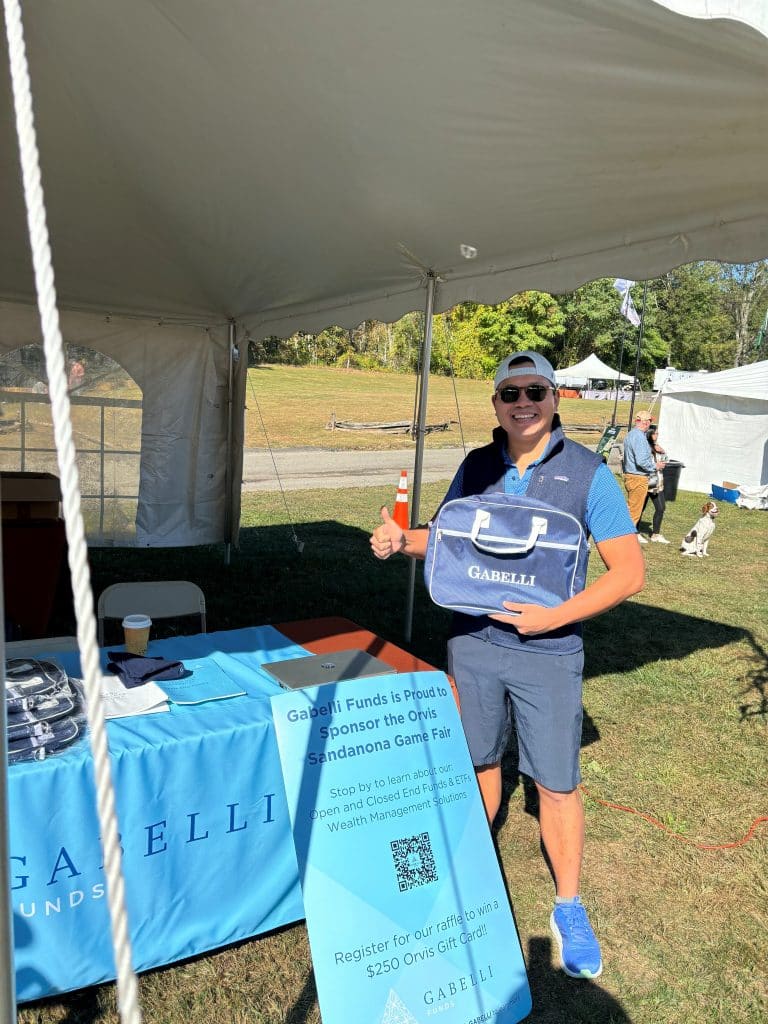Auto Symposium 2025 Las Vegas
Presenting Companies/Agenda
We cordially invite interested investors to register for our 49th Annual Automotive Symposium, either in-person or virtually, by clicking the link here or contacting Miles McQuillen (mmcquillen@gabelli.com) at 914-921-5112.
“49ers at the Encore”
In 1849, a wave of over 300,000 enterprising Americans left the comfort of the East Coast and sought fortune in the face of danger and substantial hardships, going West in search of gold. On November 3rd and 4th, under substantially less hazardous conditions, investors for the 49th year will head to the Encore at Wynn for similarly exciting ideas at our Gabelli Funds’ 49th Annual Automotive Symposium.
Taking place contemporaneously with the Automotive Aftermarket Parts Expo (AAPEX) as well as the Specialty Equipment Manufacturers Association (SEMA) conventions, the event for nearly 50 years has offered investors the chance to speak with both company executives as well as industry operators in a highly condensed period of time. Our 20+ conference participants represent the entire automotive ecosystem and showcase for investors a host of growth opportunities within the vast automotive world. Originating as an automotive aftermarket symposium, a selection of leading auto dealers, truck manufacturers, and auto and commercial truck original equipment suppliers has helped the conference evolve into a well-balanced event that enables participants to understand the interrelated drivers of the global automotive industry.
In this preview, we highlight several critical issues we expect will be discussed at length in Las Vegas. Investors will learn of an industry both at the original equipment and aftermarket level undergoing fundamental shifts that have, and will continue to alter business models for the next several decades. At the same time, our presenters are balancing short-term externalities related to tariffs and supply chain disruptions that may make it difficult for investors to look to the future. Our goal, as a team, will be to explore with our presenters where challenges that may seem daunting today actually are opportunities to create value in the days and years ahead.
What’s Ahead at the Encore?
A better question may be, “What Isn’t?”. Over the course of our two days, our conference will touch on several of the following major topics industry participants continue to face.
- Aftermarket Update – with traders focused on near term challenges for OE markets, what do all the competing variables mean for the less cyclical automotive aftermarket?
- Autonomous Driving and the Artificial Intelligence Revolution – Investors will learn how advances in AI may accelerate the path to autonomy, with impacts for both OE and Aftermarket (service and collision) participants.
- Electrification – We will seek to better understand the impacts of a near term malaise in the US, the current domestic and global adoption curve, and the looming possibility for low-cost Chinese competition to pierce the US market.
- Geopolitical Impacts and Tariffs – Supply chains adjusted for globalization have been thrown a variable due to tariffs and import duties to protect American manufacturing, leaving virtually no company in Las Vegas without the need for adjustments.
- Financing Disruptions – Recent bankruptcies at aftermarket supplier First Brands Group as well as subprime lender Tricolor Holdings have begged the question as to whether cracks in both supply chain financing and auto lending are potentially revealing greater issues ahead.
- Distribution Opportunities and Challenges – The rise of Tesla as well as Carvana (CVNA) continue to call into question the viability of legacy dealer “brick and mortar” models
- Financial Engineering – Several presenters (DAN) are currently undergoing or have the potential to undergo material transformations in terms of business segment sales or activist involvement to drive shareholder value.
As it has for nearly five decades, the Symposium may offer “gold” for those many of those willing to journey West.
Auto Aftermarket
The $400 billion United States automotive aftermarket, encompassing retail and suppliers, is experiencing significant opportunities driven by technological advancements and shifting consumer behaviors.
The automotive aftermarket faces notable challenges, particularly in supply chain disruptions and rising costs. Global supply chain issues, exacerbated by geopolitical tensions and raw material shortages, have led to delays in parts availability and increased production costs for suppliers. Retailers, in turn, struggle to maintain consistent inventory levels, which can erode customer trust and sales. Additionally, the complexity of modern vehicles, with their advanced electronics and software, requires aftermarket suppliers to invest heavily in research and development to produce compatible parts. This technological complexity also demands a higher level of expertise from retailers and technicians, creating a skills gap that can hinder service quality and customer satisfaction.
Exhibit 1 United States Light Vehicle Aftermarket
$ billions USD
The growing popularity of electric vehicles (EVs) and hybrid vehicles opens new avenues for specialized aftermarket products, such as EV-specific components, charging accessories, and performance upgrades. Increasing adoption of connected car technologies also creates demand for advanced diagnostic tools and software updates.
Autonomous Driving and the Auto Aftermarket Ecosystem
The rise of autonomous driving represents one of the most transformative shifts in the history of the automotive industry. Driven by rapid advancements in artificial intelligence, sensor technology, and connected infrastructure, vehicles are increasingly capable of handling complex driving tasks with minimal human intervention. Major automakers (TSLA) and technology firms (Waymo via Google) are investing heavily in self-driving systems, with pilot programs already operating in logistics, ride-hailing, and urban mobility. As technology matures and regulations adapt, widespread adoption could reshape not only how vehicles are used, but also how they are designed, maintained, and owned.
For the automotive aftermarket, autonomous driving brings both disruption and opportunity. Traditional revenue streams tied to parts replacement and repair—particularly those related to collision damage, braking, and manual controls—are likely to decline as self-driving vehicles reduce accidents and mechanical wear. However, new opportunities will emerge in areas such as advanced sensor calibration, software updates, cybersecurity, and fleet maintenance. The aftermarket will need to evolve from a hardware-centric model to one that integrates software diagnostics and data analytics, supporting a new generation of connected and autonomous fleets. We expect to hear from suppliers such as Standard Motor Products (SMP) and Motorcar Parts of America (MPAA) as to how they plan to both prepare for potential change as well as embracing it.
Electrification
Electrification continues to be a matter of “when” and not “if” for the global market, though the timing for mass market adoption remains unclear, particularly in the US. In the United States, vehicle electrification has experienced a notable stall in 2025, with electric vehicle (EV) sales growth decelerating amid economic pressures, policy uncertainties, and infrastructure challenges. First-half sales reached approximately 568,000 battery electric vehicles (BEVs), marking a modest 1.6% year-over-year increase, while second-quarter figures dipped 6% to around 310,000 units, largely driven by a slowdown in Tesla’s Model Y deliveries. This contrasts sharply with the 27% global surge in EV sales to 10.7 million units year-to-date, highlighting U.S.-specific headwinds such as the impending phase-out of $7,500 federal tax credits under evolving regulations and consumer hesitancy over charging availability and higher upfront costs. Overall, the domestic market share for EVs hovers around 9%, underscoring a temporary plateau in adoption as automakers grapple with inventory buildup and softening demand.
Despite the current stall, the potential for EVs in the United States remains substantial, with projections for over 4 million annual sales in the coming years infrastructure investments and stabilized incentives align (a major political question market), positioning the market for a rebound toward 25% global growth parity by 2035 amid an influx of affordable models and battery advancements.
For the aftermarket, Exhibit 2 (below) shows that, even in the most optimistic scenarios, the impact of electric vehicle adoption on the broader addressable vehicle market will remain muted. This will give industry participants time to prepare for what will eventually be a meaningful growth opportunity.
Exhibit 2 United States Automotive Population by Propulsion
Conversely, China and Europe are witnessing a robust rise in EV adoption, propelled by aggressive incentives, manufacturing scale, and regulatory mandates. In China, BEV sales soared 50% YoY in the first half, capturing 60% of global BEV volume and projecting 16-17 million total EV sales for the full year, bolstered by an expansive network of nearly 10 million charging stations and export booms in clean tech. Europe has similarly accelerated, with BEV market share climbing to 23% in the first half of 2025—up from prior years—and September registrations surging 33% to 72,779 units, The EU continues to target 18% penetration in 2025 and over 25% through 2027, reflecting commitments to emissions reductions.
Of Tariffs and Trade
We expect to hear from industry participants navigating a complex policy landscape shaped by tariffs, trade agreements, and national security reviews that together create significant uncertainty for manufacturers and suppliers. Tariffs imposed on steel and aluminum under Section 232 of the Trade Expansion Act have increased input costs for automakers and part suppliers alike, creating competitive challenges even for companies sourcing primarily within North America.
At the same time, the ongoing threat of new tariffs—particularly those targeted at vehicles and components imported from China or Europe—adds volatility to supply chain planning and capital investment decisions. Automakers are being forced to balance cost efficiency with the need for diversified sourcing, reshoring, and compliance with evolving “Buy American” provisions that can conflict with global production strategies.
The United States–Mexico–Canada Agreement (USMCA) was designed to modernize NAFTA and strengthen North American manufacturing, but its stricter rules of origin and wage requirements have introduced new challenges. Automakers and suppliers must now ensure that a higher percentage of components—especially key materials like steel, aluminum, and batteries—originate within the region and meet labor-value thresholds to qualify for tariff-free trade.
Compliance adds administrative complexity and costs, particularly for EV manufacturers whose battery supply chains remain heavily dependent on Asia. As companies adjust to these trade constraints while also facing potential shifts in Section 232 enforcement, the combined effect has been slower supply chain flexibility, higher costs, and reduced margins—forcing automakers to rethink global sourcing models and their long-term investment in North American production.
Dealers: A Shift to Direct Sales?
The traditional auto-sales paradigm—where prospective buyers come to a dealership, negotiate with salespeople, inspect vehicles in person, and then take delivery on-site—has been increasingly challenged by direct-to-consumer and online models. Several OEMs and used‐car retailers are pushing toward a more digital, streamlined buying experience, often with fixed (non-negotiable) pricing, vehicle delivery or pick-up, and less reliance on physical showrooms. A recent trend is the “agency” or direct model, where the manufacturer sets the price, owns the inventory, and acts as seller, while physical locations (if present) function more as service or display/conditioning points rather than full sales operations. This model potentially reduces overhead (real estate, staffing for bargaining, large showroom space), enables more consistent customer experience, and gives OEMs greater control over margins, pricing, and customer data.
Exhibit 3 Carvana Vending Machine
Source: Carvana
Carvana is one of the leading examples among disruptors in used-car retail. Since its founding in 2013, it has built a business around online purchase, no-haggle pricing, home delivery, and seven-day return windows, with little dependency on traditional dealerships. Strengths include convenience, transparency, and leveraging logistics and tech to scale. However, it faces significant challenges: high debt loads, capital intensity (especially in acquiring, reconditioning, storing, and delivering inventory), risks from economic downturns and rising interest rates, and regulatory/legal hurdles in some states and markets.
Because of these risks, while Carvana and similar models are pushing the industry forward, it’s not yet clear whether they will fully displace the legacy dealer model—or force it to adapt—for all segments and geographies. Legacy dealers still retain advantages in in-person inspection and local presence, brand relationships, service/repair infrastructure, and regulatory protection in many states.
First Brands Group Bankruptcy
The announcement of First Brands Group Chapter 11 filing put a spotlight on the longstanding automotive aftermarket industry practice of “Reverse Factoring,” whereby large retailers (like AZO and ORLY) work with financial institutions to allow suppliers to be paid earlier (at a discount) while the retailer preserves longer payment terms. This structure helps stabilize smaller suppliers’ cash flow and reduces the risk of disruptions due to liquidity stress. However, it also introduces hidden leverage: if the buyer’s credit deteriorates or a financing partner withdraws support (as was the case with First Brands), suppliers can suddenly lose a key source of liquidity. In the wake of an event like First Brands’ bankruptcy, reverse factoring programs can expose how dependent the aftermarket ecosystem has become on this form of off-balance-sheet financing — with potential ripple effects if those arrangements unwind or confidence erodes. We expect to explore with industry participants this practice and whether the FBG bankruptcy may disrupt Reverse Factoring usage going forward.
©Gabelli Funds 2025
191 MASON STREET GREENWICH, CT 06830, Gabelli Funds, TEL (914) 921-5100
This whitepaper was prepared by Brian Sponheimer, Carolina Jolly, CFA and Eddie Nakamura. The examples cited herein are based on public information and we make no representations regarding their accuracy or usefulness as precedent. The Portfolio Manager’s views are subject to change at any time based on market and other conditions. The information in this report represent the opinions of the individual Portfolio Manager as of the date hereof and is not intended to be a forecast of future events, a guarantee of future results, or investments advice. The views expressed may differ from other portfolio managers or of the Firm as a whole.
As of June 30, 2025, affiliates of GAMCO Investors, Inc. beneficially owned 4.0% of Dana, and less than 1% of all other companies mentioned.
This whitepaper is not an offer to sell any security nor is it a solicitation of an offer to buy any security.
Investors should consider the investment objectives, risks, sales charges and expense of the fund carefully before investing.
For more information, visit our website at: www.gabelli.com or call: 800-GABELLI
800-422-3554 • 914-921-5000 • Fax 914-921-5098 • info@gabelli.com









